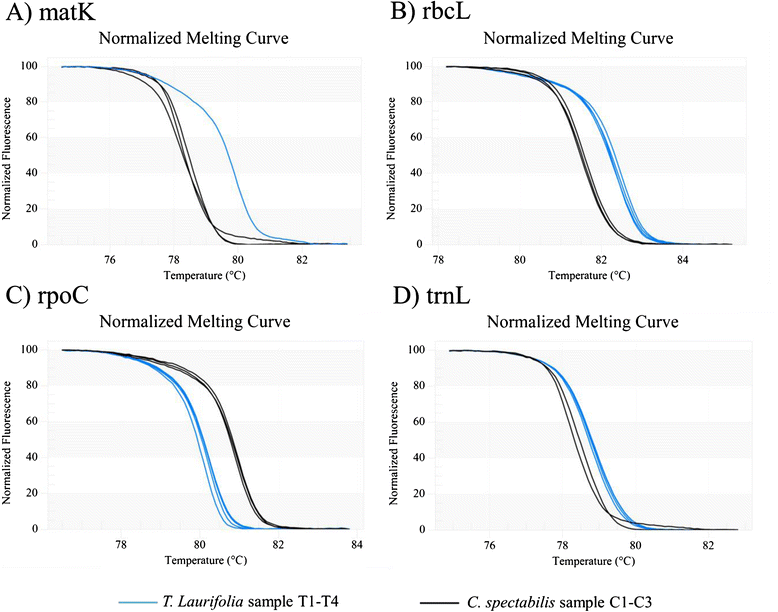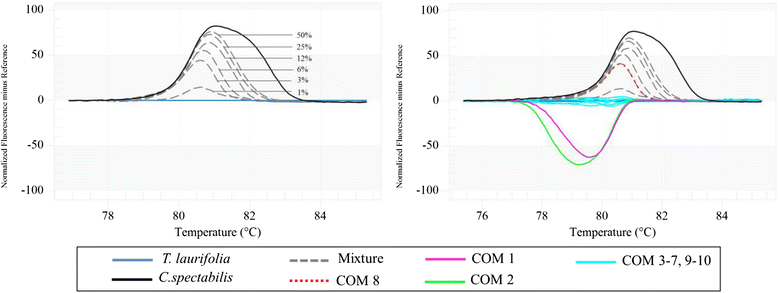Fast and reliable detection of toxic Crotalaria spectabilis Roth. in Thunbergia laurifolia Lindl. herbal products using DNA barcoding coupled with HRM analysis
- PMID: 26024888
- PMCID: PMC4448308
- DOI: 10.1186/s12906-015-0692-6
Fast and reliable detection of toxic Crotalaria spectabilis Roth. in Thunbergia laurifolia Lindl. herbal products using DNA barcoding coupled with HRM analysis
Abstract
Background: Nowadays, medicinal plants are used as a popular alternative to synthetic drugs. Many medicinal plant products have now been commercialized throughout various markets. These products are commonly sold in processed or modified forms such as powders, dried material and capsules, making it almost impossible to accurately identify the constituent species. The herbal plant known as 'Rang Chuet' in Thai has been widely used as remedies for various ailments. However, two medicinal plants species, Thunbergia laurifolia and Crotalaria spectabilis share this name. Duo to the similarity in nomenclature, the commercial products labeled as 'Rang Chuet' could be any of them. Recently, the evidence of hepatotoxic effects linked to use of C. spectabilis were reported and is now seriously concern. There is a need to find an approach that could help with species identification of these herbal products to ensure the safety and efficacy of the herbal drug.
Methods: Here DNA barcoding was used in combination with High Resolution Melting analysis (Bar-HRM) to authenticate T. laurifolia species. Four DNA barcodes including matK, rbcL, rpoC and trnL were selected for use in primers design for HRM analysis to produce standard melting profiles of the selected species. Commercial products labeled as 'Rang Chuet' were purchased from Thai markets and authentication by HRM analyses.
Results: Melting data from the HRM assay using the designed primers showed that the two 'Rang Chuet' species could easily be distinguished from each other. The melting profiles of the all four region amplicons of each species are clearly separated in all three replicates. The method was then applied to authenticate products in powdered form. HRM curves of all ten test samples indicated that three of the tested products did not only contain the T. laurifolia species.
Conclusion: The herbal drugs derived from different plants must be distinguished from each other even they share the same vernacular name. The Bar-HRM method developed here proved useful in the identification and authentication of herbal species in processed samples. In the future, species authentication through Bar-HRM could be used to promote consumer trust, as well as raising the quality of herbal products.
Figures


Similar articles
-
Should DNA sequence be incorporated with other taxonomical data for routine identifying of plant species?BMC Complement Altern Med. 2017 Aug 31;17(1):437. doi: 10.1186/s12906-017-1937-3. BMC Complement Altern Med. 2017. PMID: 28859638 Free PMC article.
-
Bar-HRM for Authentication of Plant-Based Medicines: Evaluation of Three Medicinal Products Derived from Acanthaceae Species.PLoS One. 2015 May 26;10(5):e0128476. doi: 10.1371/journal.pone.0128476. eCollection 2015. PLoS One. 2015. PMID: 26011474 Free PMC article.
-
Hybrid analysis (barcode-high resolution melting) for authentication of Thai herbal products, Andrographis paniculata (Burm.f.) Wall.ex Nees.Pharmacogn Mag. 2016 Jan;12(Suppl 1):S71-5. doi: 10.4103/0973-1296.176112. Pharmacogn Mag. 2016. PMID: 27041863 Free PMC article.
-
Progress in the use of DNA barcodes in the identification and classification of medicinal plants.Ecotoxicol Environ Saf. 2021 Jan 15;208:111691. doi: 10.1016/j.ecoenv.2020.111691. Epub 2020 Nov 28. Ecotoxicol Environ Saf. 2021. PMID: 33396023 Review.
-
DNA barcoding: an efficient tool to overcome authentication challenges in the herbal market.Plant Biotechnol J. 2016 Jan;14(1):8-21. doi: 10.1111/pbi.12419. Epub 2015 Jun 16. Plant Biotechnol J. 2016. PMID: 26079154 Free PMC article. Review.
Cited by
-
Should DNA sequence be incorporated with other taxonomical data for routine identifying of plant species?BMC Complement Altern Med. 2017 Aug 31;17(1):437. doi: 10.1186/s12906-017-1937-3. BMC Complement Altern Med. 2017. PMID: 28859638 Free PMC article.
-
Mitigating the Impact of Admixtures in Thai Herbal Products.Front Pharmacol. 2019 Oct 15;10:1205. doi: 10.3389/fphar.2019.01205. eCollection 2019. Front Pharmacol. 2019. PMID: 31749698 Free PMC article. Review.
-
Evaluation of a DNA-based method for spice/herb authentication, so you do not have to worry about what is in your curry, buon appetito!PLoS One. 2017 Oct 11;12(10):e0186283. doi: 10.1371/journal.pone.0186283. eCollection 2017. PLoS One. 2017. PMID: 29020084 Free PMC article.
-
Advancements and future prospective of DNA barcodes in the herbal drug industry.Front Pharmacol. 2022 Oct 21;13:947512. doi: 10.3389/fphar.2022.947512. eCollection 2022. Front Pharmacol. 2022. PMID: 36339543 Free PMC article. Review.
-
The Potential Power of Bar-HRM Technology in Herbal Medicine Identification.Front Plant Sci. 2016 Mar 30;7:367. doi: 10.3389/fpls.2016.00367. eCollection 2016. Front Plant Sci. 2016. PMID: 27066026 Free PMC article. Review.
References
-
- Kunle OF, Egharevba HO, Ahmadu PO. Standardization of herbal medicines - A review. IJBC. 2012;4(3):101–112.
-
- Chan EWC, Lim YY. Antioxidant activity of Thunbergia laurifolia tea. JTFS. 2006;18:130–136.
-
- Suwanchaikasem P, Chaichantipyuth C, Amnuoypol S, Sukrong S. Random amplified polymorphic DNA analysis of Thunbergia laurifolia Lindl. and its related species. JMPR. 2012;6:2955–61.
-
- Suwanchaikasem P, Phadungcharoen T, Sukrong S. Authentication of the Thai medicinal plants sharing the same common name ‘Rang Chuet’: Thunber gia laurifolia, Crotalaria spectabilis, and Curcuma aff. amada by combined techniques of TLC, PCR-RFLP fingerprints, and antioxidant activities. ScienceAsia. 2013;39:124–133. doi: 10.2306/scienceasia1513-1874.2013.39.124. - DOI
Publication types
MeSH terms
Substances
LinkOut - more resources
Full Text Sources
Other Literature Sources
Miscellaneous

